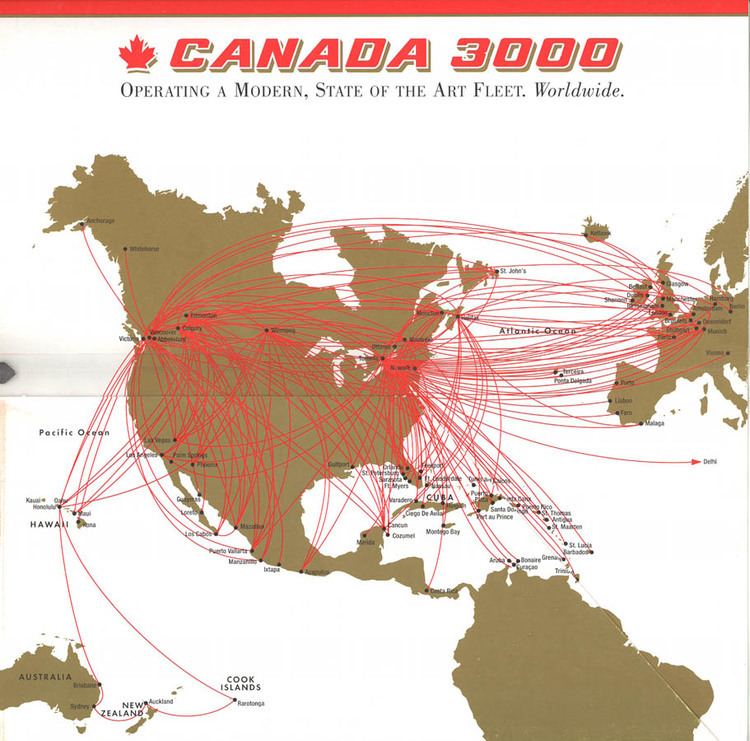2T CMM Destinations 91 Fleet size 68 | CMM ELITE Parent company None Founded 1988 Ceased operations November 8, 2001 | |
 | ||
Hubs Toronto Pearson International Airport, Vancouver International Airport | ||
Canada 3000 Inc. was a Canadian discount charter airline offering domestic and international flights. It was the largest charter airline in the world at the time of its operation, with over 90 destinations worldwide, although it changed to scheduled service in 2000 after the Canadian Airlines and Air Canada merger. Canada 3000 competed with Air Canada, WestJet, and fellow charter airline Air Transat. In November 2001, the airline went out of business after a sharp decline in revenues following the September 11, 2001, terrorist attacks in the United States. There have been several attempts to restart the airline since then. The airline was headquartered in Etobicoke in the west-end of Toronto, Ontario.
Contents
History
The airline was created in 1988 by British airline Air 2000, initially for charter service to lease some of its airplanes for Canadian charter travel. The airline was denied license to operate by the National Transport Agency NTA because of the control and ownership of the UK firm. Air 2000 dropped out of an ownership position, and the airline started operations in December 1988. In May 1989, by order of the NTA, it changed its name to 'Canada 3000'. The next year the airline acquired Vacationair and a subsidiary was created in Mexico with the name Aerofiesta. The company's owners were the Deluce family (25%), chairman John Lecky (45%) and Adventure Tours (30%). Following the demise of Wardair, the company's goal was to become Canada's largest charter carrier, a position it attained in 1991.
In 1998, co-founder and CEO Angus Kinnear was the recipient of the Tony Jannus Award for his contributions to commercial air transportation. As of 1998, the airline carried over 2.5 million passengers annually, including destinations in 22 countries. In April 1998, Canada 3000 became the launch customer and first commercial operator of the Airbus A330-200.
In 1999, Canada 3000 purchased Holiday Travel Consultants based out of Vancouver from Richard and Shelley Carlin which expanded to become Canada 3000's retail division under the name Canada 3000 Tickets. By the time it closed its doors, Canada 3000 had expanded its retail division to include 40 branch offices as well as three call centers in Montreal, Toronto and Vancouver.
In 2000, Canada 3000 went public, raising $30 million in an IPO. In January 2001, Canada 3000 bought charter carrier Royal Aviation or Royal Airlines of Montreal, Quebec for $84 million. The company also acquired the Royal Airlines' cargo operation, renaming it Canada 3000 Cargo. In March 2001 it also took over CanJet Airlines for $7.5 million in stock. In May 2001, following the merger of Canadian Airlines International with Air Canada, Canada 3000 also started operating scheduled flights. In October 2001, one month before its demise, Canada 3000 became the first airline to operate non-stop service from North America to India.
On November 8, 2001 the company suddenly collapsed with no warning for travelers or employees. The company filed for bankruptcy, citing a downturn in air travel during the weeks following the September 11, 2001 terrorist attacks on the United States. The fleet was left grounded at various airports around the world, leaving 50,000 vacationers stranded. September 10, 2001 was a record booking day, but within a few days air traffic declined by 50%. The airline was offered a $75 million loan guarantee from the Canadian government under the condition of a 'viable business plan' being produced. By November 7, 2001, the airline had $260 million in debt, and only had $1.49 million in cash. In secret, it had applied to the Canada Labour Board for permission to cut labour costs by 30% by closing its Royal division immediately. The Board would not approve without union agreement. Union offers to cut 700 pilot and flight attendant positions did not provide enough savings immediately and the airline applied for bankruptcy protection on November 8, while it planned to continue flying. By the end of the day, airport authorities in Toronto and St. John's, Newfoundland has seized planes under court authority and the company directors decided to cease operations.
Out of bankruptcy, the Canada 3000 Cargo air cargo operation, which was still operating, was sold off and became Cargojet Airways, run by former Canada 3000 executive Ajay Virmani. In 2002, Michel Leblanc, the former owner of Royal Airlines and later a director with Canada 3000 went on to form another scheduled discount airline, Jetsgo, which lasted almost three years before it too collapsed and filed for bankruptcy protection on March 11, 2005. The CEO, Robert Deluce continued in the airline business to make the successful Porter Airlines out of Toronto's Billy Bishop airport.
In 2005 a group of investors had planned to launch a new Canada 3000, with two Boeing 757-200 aircraft (ref: Flight International, April 2005).
Fleet
Canada 3000 operated the following fleet, with current allocations as of December, 2013:
